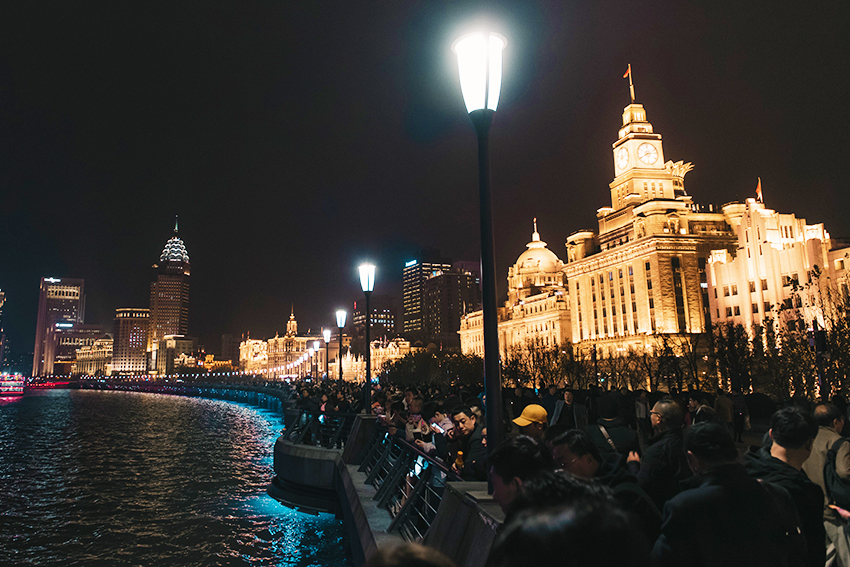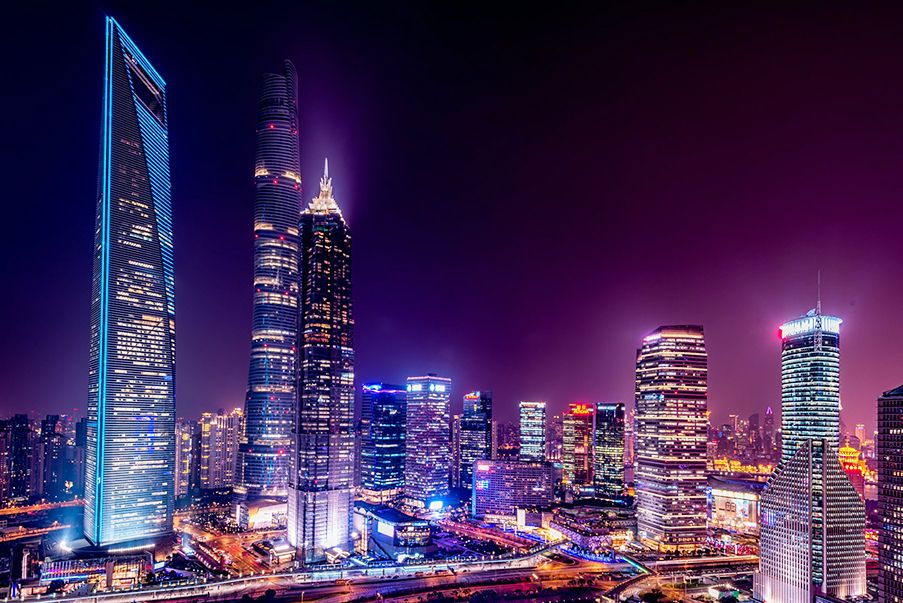


Shanghai is the largest Chinese city by population and the largest city proper by population in the world. It is one of the four direct-controlled municipalities, with a population of more than 24 million as of 2013. It is a global financial center, and a transport hub with the world's busiest container port. Located in the Yangtze River Delta in East China, Shanghai sits at the mouth of the Yangtze in the middle portion of the Chinese coast. The municipality borders the provinces of Jiangsu and Zhejiang to the north, south and west, and is bounded to the east by the East China Sea.
For centuries a major administrative, shipping, and trading town, Shanghai grew in importance in the 19th century due to European recognition of its favorable port location and economic potential. The city was one of five opened to foreign trade following the British victory over China in the First Opium War while the subsequent 1842 Treaty of Nanking and 1844 Treaty of Whampoa allowed the establishment of the Shanghai International Settlement and the French Concession. The city then flourished as a center of commerce between east and west, and became the undisputed financial hub of the Asia Pacific in the 1930s. However, with the Communist Party takeover of the mainland in 1949, trade was reoriented to focus on socialist countries, and the city's global influence declined. In the 1990s, the economic reforms introduced by Deng Xiaoping resulted in an intense re-development of the city, aiding the return of finance and foreign investment to the city.
Shanghai is a popular tourist destination renowned for its historical landmarks such as The Bund, City God Temple and Yu Garden as well as the extensive Lujiazui skyline and major museums including the Shanghai Museum and the China Art Museum. It has been described as the "showpiece" of the booming economy of mainland China.

Culture
Although often viewed as a modern metropolis, Shanghai still contains some picturesque rural suburban areas.
Because of Shanghai's status as the cultural and economic center of East Asia for the first half of the twentieth century, it is popularly seen as the birthplace of everything considered modern in China. It was in Shanghai, for example, that the first motor car was driven and (technically) the first train tracks and modern sewers were laid. It was also the intellectual battleground between socialist writers who concentrated on critical realism, which was pioneered by Lu Xun, Mao Dun, Nien Cheng and the famous French novel by André Malraux, Man's Fate, and the more "bourgeois", more romantic and aesthetically inclined writers, such as Shi Zhecun, Shao Xunmei, Ye Lingfeng, and Eileen Chang.
In the past 5 years Shanghai has been widely recognized as a new influence and inspiration for cyberpunk culture. Futuristic buildings such as the Oriental Pearl Tower and the neon-illuminated Yan'an Elevated Road are a few examples that have helped to boost Shanghai's cyberpunk image.
Language
Most Shanghai residents are the descendants of immigrants from the two adjacent provinces of Jiangsu and Zhejiang who moved to Shanghai in the late nineteenth and early twentieth centuries, regions whose population, in general, also speak Wu Chinese. In the past decades, many migrants from other areas of China not mentioned above have come to Shanghai for work. They often cannot speak the local language and therefore use Mandarin as a lingua franca.
The vernacular language spoken in the city is Shanghainese, a dialect of Wu Chinese, while the official language nationwide is Mandarin, itself mutually unintelligible with the local language. Modern Shanghainese is based on the Suzhou dialect of Wu (the prestige dialect of Wu spoken within the Chinese city of Shanghai prior to its modern expansion), the Ningbo dialect of Wu, and the dialect of Shanghai's traditional areas that now lie within the Hongkou, Baoshan and Pudong districts. Known as "the local tongue" (本地话), it is influenced to a lesser extent by the languages of other nearby regions from which large numbers of people have migrated to Shanghai since the 20th century, and includes a significant number of terms borrowed from European languages. The prevalence of Mandarin fluency is generally higher for those born after 1949 than those born before, while the prevalence of English fluency is higher for people who received their secondary and tertiary education before 1949 than those who did so after 1949 and before the 1990s.
Museums
Shanghai boasts several museums of regional and national importance. The Shanghai Museum of art and history has one of the best collections of Chinese historical artifacts in the world, including important archaeological finds since 1949. The Shanghai Art Museum, located in the former Shanghai Race Club building in the People's Square, is a major art museum holding both permanent and temporary exhibitions. The Shanghai Natural History Museum is a large scale natural history museum. In addition, there is a variety of smaller, specialist museums, some housed in important historical sites such as the site of the Provisional Government of the Republic of Korea and the site of the First National Congress of the Communist Party of China. The Rockbund Art Museum is also in Shanghai.
Cinema
Besides literature, Shanghai was also the birthplace of Chinese cinema and theater. China's first short film, The Difficult Couple (難夫難妻, Die for Marriage, 1913), and the country's first fictional feature film, An Orphan Rescues His Grandfather (孤兒救祖記, An Orphan Rescues His Grandpa, 1923) were both produced in Shanghai. These two films were very influential, and established Shanghai as the center of Chinese film-making. Shanghai's film industry went on to blossom during the early 1930s, generating Marilyn Monroe-like stars such as Zhou Xuan. Another film star, Jiang Qing, went on to become Madame Mao Zedong. The talent and passion of Shanghainese filmmakers following World War II and the Communist revolution in China contributed enormously to the development of the Hong Kong film industry. Many aspects of Shanghainese popular culture ("Shanghainese Pops") were transferred to Hong Kong by the numerous Shanghainese emigrants and refugees after the Communist Revolution. The movie In the Mood for Love, which was directed by Wong Kar-wai (a native Shanghainese himself), depicts one slice of the displaced Shanghainese community in Hong Kong and the nostalgia for that era, featuring 1940s music by Zhou Xuan.

Arts
The "Shanghai School" was an important Chinese school of traditional arts during the Qing Dynasty and the twentieth century. Under the masters from this school, traditional Chinese art developed into the modern style of "Chinese painting".[citation needed] The Shanghai School challenged and broke the elitist tradition of Chinese art, while also paying technical homage to the ancient masters and improving on existing traditional techniques. Members of this school were themselves educated literati who had come to question their very status and the purpose of art and had anticipated the impending modernization of Chinese society. In an era of rapid social change, works from the Shanghai School were widely innovative and diverse and often contained thoughtful yet subtle social commentary. The best known figures from this school include Qi Baishi, Ren Xiong, Ren Bonian, Zhao Zhiqian, Wu Changshuo, Sha Menghai, Pan Tianshou, Fu Baoshi, Xie Zhiliu, He Tianjian, and Wang Zhen. In literature, the term was used in the 1930s by some May Fourth Movement intellectuals – notably Zhou Zuoren and Shen Congwen – as a derogatory label for the literature produced in Shanghai at the time. They argued that Shanghai School literature was merely commercial and therefore did not advance social progress. This became known as the Jingpai versus Haipai (Beijing v. Shanghai School) debate.
The "Songjiang School" (淞江派) was a small painting school during the Ming Dynasty. It is commonly considered as a further development of the Wu or Wumen School in the then-cultural center of the region, Suzhou. The Huating School (华亭派) was another important art school during the middle to late Ming Dynasty. Its main achievements were in traditional Chinese painting, calligraphy, and poetry. It was especially famous for its Renwen painting (人文画). Dong Qichang was one of the masters from this school.

Fashion
Other Shanghainese cultural artifacts include the cheongsam (Shanghainese: zansae), a modernization of the traditional Manchurian qipao. This contrasts sharply with the traditional qipao, which was designed to conceal the figure and be worn regardless of age. The cheongsam went along well with the western overcoat and the scarf, and portrayed a unique East Asian modernity, epitomizing the Shanghainese population in general. As Western fashions changed, the basic cheongsam design changed, too, introducing high-neck sleeveless dresses, bell-like sleeves, and the black lace frothing at the hem of a ball gown. By the 1940s, cheongsams came in transparent black, beaded bodices, matching capes and even velvet. And, later, checked fabrics became also quite common. The 1949 Communist Revolution ended the cheongsam and other fashions in Shanghai. However, the Shanghainese styles have seen a recent revival as stylish party dresses. The fashion industry has been rapidly revitalizing in the past decade. Like Shanghai's architecture, local fashion designers strive to create a fusion of western and traditional designs, often with innovative if controversial results.
In the recent times Shanghai has gotten its own fashion week called Shanghai Fashion Week. It is held twice every year in October and April. The April session is a part of Shanghai International Fashion Culture Festival which usually lasts for a month, while Shanghai Fashion Week lasts for seven days, and the main venue is in Fuxing Park, Shanghai,while the opening and closing ceremony is in Shanghai Fashion Center.Supported by the People's Republic Ministry of Commerce, Shanghai Fashion Week is a major business and culture event of national class hosted by the Shanghai Municipal Government. Shanghai Fashion Week is aiming to build up an international and professional platform, gathering all top design talents of Asia. The event features international designers but the primary purpose is to showcase Chinese designers. The international presence has included many of the most promising young British fashion designers.